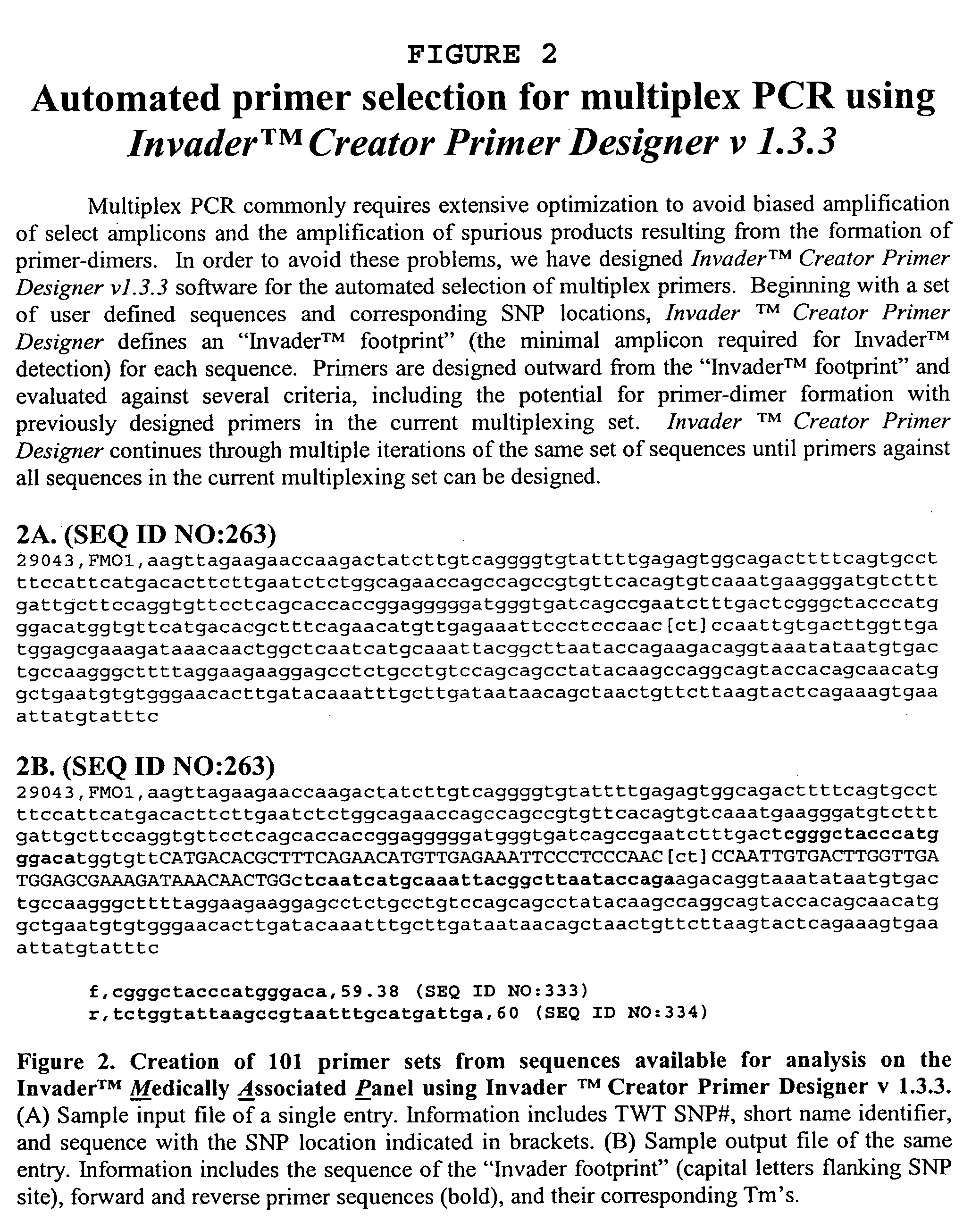Characterization of CYP 2D6 genotypes
a technology of cyp 2d6 and genotype, applied in the field of developing and optimizing nucleic acid detection assays, can solve the problems of inability to obtain and validate information on the frequency and clinical relevance of many polymorphisms and other variations, failure of attempts to analyze individuals based on genome sequence information, and failure of probes generated based on reference sequences
- Summary
- Abstract
- Description
- Claims
- Application Information
AI Technical Summary
Benefits of technology
Problems solved by technology
Method used
Image
Examples
example 1
A. Designing A 10-plex (Manual): Test for Invader Assays
[0226] The following experimental example describes the manual design of amplification primers for a multiplex amplification reaction, and the subsequent detection of the amplicons by the INVADER assay. These data are additionally described in U.S. patent application Ser. No. 10 / 321,039, filed Dec. 17, 2002, incorporated herein by reference.
[0227] Ten target sequences were selected from a set of pre-validated SNP-containing sequences, available in a TWT in-house oligonucleotide order entry database. Each target contains a single nucleotide polymorphism (SNP) to which an INVADER assay had been previously designed. The INVADER assay oligonucleotides were designed by the INVADER CREATOR software (Third Wave Technologies, Inc. Madison, Wis.), thus the footprint region in this example is defined as the INVADER “footprint”, or the bases covered by the INVADER and the probe oligonucleotides, optimally positioned for the detection of...
example 2
Design of 101-plex PCR using the Software Application
[0244] Using the TWT Oligo Order Entry Database, 144 sequences of less than 200 nucleotides in length were obtained with SNP annotated using brackets to indicate the SNP position for each sequence (e.g. NNNNNNN[N(wt) / N(mt)]NNNNNNNN). In order to expand sequence data flanking the SNP of interest, sequences were expanded to approximately 1 kB in length (500 nts flanking each side of the SNP) using BLAST analysis. Of the 144 starting sequences, 16 could not expanded by BLAST, resulting in a final set of 128 sequences expanded to approximately 1 kB length. These expanded sequences were provided to the user in Excel format with the following information for each sequence; (1) TWT Number, (2) Short Name Identifier, and (3) sequence. The Excel file was converted to a comma delimited format and used as the input file for Primer Designer INVADER CREATOR v1.3.3. software (this version of the program does not screen for FRET reactivity of t...
example 3
Characterization of Cytochrome p450 2D6 Alleles Using Triplex PCR and the INVADER Assay System
[0247] The field of pharmacogenetics is advancing rapidly as increasing numbers of functional polymorphisms in proteins essential for drug action are identified. One of the most clinically important of these proteins is an enzyme in the cytochrome P450 family, debrisoquine 4-hydroxylase, or cytochrome P450 2D6 (CYP2D6), the gene for which is found on chromosome band 22q13.1. This enzyme metabolizes about 25% of all therapeutic drugs, including beta-blockers, serotonin reuptake inhibitors, anti-emetics, tricyclic anti-depressants, anti-arrhythmics, and nicotine. In addition, CYP2D6 metabolizes many environmental xenobiotic substances. Hence, the metabolic status of the enzyme has been linked to a wide range of illnesses such as liver cancer (Agundez, J. A., et al. Lancet, 1995. 345(8953):830) and Parkinson's disease (Smith, C. A., et al. Lancet, 1992. 339(8806):1375).
[0248] Currently, more...
PUM
| Property | Measurement | Unit |
|---|---|---|
| melting temperature | aaaaa | aaaaa |
| melting temperature | aaaaa | aaaaa |
| temperature | aaaaa | aaaaa |
Abstract
Description
Claims
Application Information
 Login to View More
Login to View More - R&D
- Intellectual Property
- Life Sciences
- Materials
- Tech Scout
- Unparalleled Data Quality
- Higher Quality Content
- 60% Fewer Hallucinations
Browse by: Latest US Patents, China's latest patents, Technical Efficacy Thesaurus, Application Domain, Technology Topic, Popular Technical Reports.
© 2025 PatSnap. All rights reserved.Legal|Privacy policy|Modern Slavery Act Transparency Statement|Sitemap|About US| Contact US: help@patsnap.com



